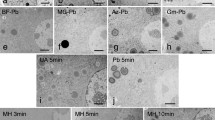Abstract
A simple, rapid method is described for the polychromatic coloration of semithin sections, which is applicable to material routinely processed for transmission electron microscopy. Material fixed with a glutaraldehyde-paraformaldehyde mixture and postfixed in osmium tetroxide with or without potassium ferrocyanide and embedded in different types of resin (Durkupan-ACM, Spurr resin, Taab resin) can be used. Constant and homogenous results are obtained with this technique, the staining procedure being achieved at room temperature in no more than 10 min. Sections of 0.5–1 μm in thickness are oxidised and bleached. After washing, sections are stained in two steps with carbol methylene blue/carbol gentian violet solution and pararosaniline solution. Using the method described in this paper, a polychromatic coloration of the different cells and tissues was obtained (epithelial cells in various shades of blue-violet, connective tissue and elastic laminae of blood vessels in pink or red, etc.). This procedure provides greater contrast between cytoplasm and nuclei, and among the different types of cells and tissues than is seen with toluidine blue, which is very useful for observation and photography of semithin sections. Polychromatic methods found in the literature are normally complex and require a lengthy staining time or cannot be applied on material routinely processed for transmission electron microscopy. Our method is simple, rapid and can be used on any type of material routinely processed for transmission electron microscopy and embedded in epoxy resins.
Similar content being viewed by others
References
Alsop DW (1974) Rapid single solution polychrome staining of semithin epoxy sections using polyethylene glycol 200 as a stain solvent. Stain Technol 49:265–272
Armas-Portela R, Gutierrez-Gonzalvez MG, Stockert J (1984) Orthochromatic and metachromatic staining reactions by pyronin Y on epon semithin sections. Acta Histochem (Jena) 74:1–4
Berkowitz L, Fiorello O, Kruger L, Maxwell D (1968) Selective staining of nervous tissue for light microscopy following preparation for electron microscopy J Histochem Cytochem 16:808–811
Cañete M, Stockert J (1981) Polychromatic Giesma staining for Epon semithin sections. J Microsc 122:321–324
Causton BE (1985) Does the embedding chemistry interact with tissue? In: Müller M, Becker R, Boyde A, Wolosewick J (eds) Science of biological specimen preparation. SEM, O'Hare, Ill., pp 209–214
Chang S (1972) Hematoxylin-eosin staining of plastic embedded tissue sections. Arch Pathol 93:344–351
Crivellato E, Zweyer M, Basa M, Mallardi F (1990) A ruthenium red-toluidine blue procedure for staining epoxy sections in light microscopy. Z Mikrosk Anat Forsch 104:769–778
Crowley H (1989) Improving stain penetration into epoxy resin sections for light microscopy. Stain Technol 64:98–100
Diez de Rada O, Sesma P, Lopez J, Vázquez J, Dezarate A (1986) Giemsa stain applied to deplasticized sections to identify pancreatic islet cells. Stain Technol 61:367–374
Fritsch H (1989) Staining of different tissues in thick epoxy resin-impregnated sections of human fetuses. Stain Technol 64:75–79
Gandor DW, Meyer J (1988) A simple two-dye basic stain facilitating recognition of mitosis in plastic embedded tissue sections. Stain Technol 63:75–81
Gori P (1977) Ponceau 2R staining on semithin-sections of tissues fixed in glutaraldehyde-osmium tetroxide and embedded in epoxy resins. J Microsc 110:163–165
Grimley P (1964) A tribasic stain for thin sections of plastic embedded, osmium tetroxide-fixed tissue. Stain Technol 39:229–233
Hayat MA (1981) Fixation for electron microscopy. Academic Press, New York
Hayat MA (1986) Basic techniques for transmission electron microscopy. Academic Press, Orlando, Florida
Heath E, (1970) The use of performic acid oxidation to facilitate differential staining of epoxy-embedded adenohypophysis. Z Zellforsch Mikrosk Anat 107:1–3
Horobin RW (1983) Staining plastic sections: a review of problems, explanations and possible solutions. J Microsc 131:173–186
Knight D (1977) Cytological staining methods in electron microscopy In: Lewis P, Knight D (eds) Staining methods for sectioned material. Elsevier/North-Holland, Amsterdam, pp 25–76
Lane B, Europa D (1965) Differential staining of ultrathin sections of Epon-embedded tissues for light microscopy. J Histochem Cytochem 13:579–582
Lopez M, Kornegay R (1991) multichromatic stain for Lowicryl K4M embedded tissues. Biotech Histochem 1:35–36
Martin J, Lynn J, Nickey W (1966) A rapid polychrome stain for epoxy embedded tissue. Am J Clin Pathol 46:250–251
Pasyk S, Bartosik W, Fabry A (1989) Polychrome staining of epoxy semithin sections using cacodylic buffer as a stain solvent. Stain Technol 64:149
Pease D (1964) Histological techniques for electron microscopy, 2nd edn. Academic Press, New York
Pool C (1969) Hematoxylin-eosin staining of OsO4-fixed Eponembedded tissue: prestaining oxidation by acidified H2O2. Stain Technol 44:75–77
Sevier A, Munger B (1968) The use of oxone to facilitate specific tissue stainability following osmium fixation. Anat Rec 162:43–45
Smith N, Kilpatrick J, Bain A (1985) Staining large epoxy resin embedded histologic sections by a simplified hematoxylin and eosin method using heat. Stain Technol 60:59–61
Spurlock B, Skinner M, Kattine A (1966) A simple rapid method for staining epoxy embedded specimens for light microscopy with the polychromatic stain paragon-1301. Am J Clin Pathol 46:252–258
Tato A, Planes M, Ramos A, Stockert J, Ferrer J (1991) Differential staining of mucin granules from epoxy resin sections by a phosphotungstic acid-methyl green procedure. Biotech Histochem 66:139–144
Trump BF, Smuckler AE, Benditt EP (1961) A method for staining epoxy sections for light microscopy. J Ultrastruct Res 5:343–348
Author information
Authors and Affiliations
Rights and permissions
About this article
Cite this article
Tolivia, J., Navarro, A. & Tolivia, D. Polychromatic staining of epoxy semithin sections: a new and simple method. Histochemistry 101, 51–55 (1994). https://doi.org/10.1007/BF00315831
Accepted:
Issue Date:
DOI: https://doi.org/10.1007/BF00315831




